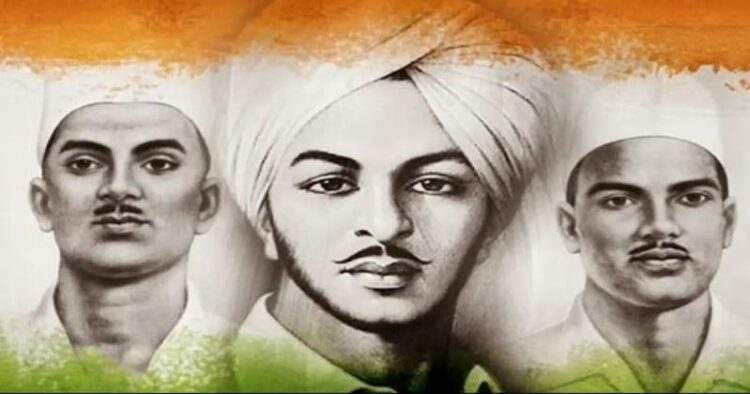On March 23, 1931, when Bhagat Singh, Rajguru and Sukhdev were hanged in the Lahore Central Jail, a wave of anger against the British ran across the country. After stepping up the gallows, all three first kissed the noose and then, with their own hands, happily put that noose around their neck. Seeing this, the jail warden said, “These youths have lost their minds; they are mad.”
Bhagat Singh’s ideology was shaped from a very young age, and he was under the heavy influence of his father, Sardar Kishan Singh and his uncle Ajit Singh. When Bhagat Singh was in DAV College, Lahore, he was highly impressed by the ideas of Bhai Parmanand and Jai Chand Vidyalankar, two veteran nationalists.
Rajguru received primary education at Khed and later studied at New English High School in Pune. He joined Seva Dal at a young age. He attended a training camp conducted by Dr NS Hardikar at Ghatprabha. Sukhdev witnessed the brutal atrocities that the Imperial British Raj had inflicted on India, which then led him to join the revolutionaries, vowing to set India free from the shackles of British dominion. He actively educated the youth at National Law College, Lahore, about India’s glorious past. Most importantly, all these three were active members of ‘Naujawan Bharat Sabha’ and unique heroes of ‘The Hindustan Socialist Republican Association.’
With the slogan ‘Simon, go back,’ Lala Lajpat Rai organised a peaceful demonstration against Sir John Simon’s visit to Lahore on October 30, 1928. James A. Scott, Superintendent of Police, issued an order for the police to lathi-charge demonstrators despite the peaceful nature of the demonstration. During the altercation, Lala Lajpat Rai suffered fatal injuries and succumbed to his injuries on November 17 1928. This enraged the youth of the nation. Bhagat Singh, Rajguru, Sukhdev, and Chandra Shekhar Azad, these young revolutionary freedom fighters, planned to kill James Scott. However, they killed John P Saunders, an additional superintendent of police, by mistake on December 17, 1928.
Immediately after this incident, Bhagat Singh left for Calcutta in disguise. While living there, Bhagat Singh learned the method of making bombs. Bhagat Singh, Rajguru and Sukhdev firmly believed that the policies of non-violence could not cut the shackles of slavery in India. For this reason, Bhagat Singh and his companion Batukeshwar Dutt threw a bomb inside the Central Assembly on April 8, 1929. They also intended to prevent the passage of the Trade Dispute Act and the Public Safety Bill.
They stood in the visitors’ gallery and kept distributing pamphlets peacefully, on which they had written their objective of complete independence of Mother India and kept shouting slogans of ‘Inquilab Zindabad’. The aim was not to kill anyone but to create awareness among the people of the country. After throwing the bomb, Bhagat Singh and Batukeshwar Dutt surrendered themselves to the police.
Sardar Bhagat Singh, Rajguru and Sukhdev were sentenced to death on October 7, 1930 for the crime of throwing bombs. Despite this being opposed everywhere, on March 23, 1931, the three sons of Bharat Mata were hanged in Lahore Jail, and the police burnt their bodies in Ferozepur (Punjab) at night. The British had hanged these three before the due date. The three were to be hanged on March 24. But in view of public anger in the country, he was hanged confidentially a day earlier. The entire hanging process was kept secret.
A wave of mourning ran across the country, and on the sacrifice of these martyrs, March 23 was observed as a mourning day. This day in history is celebrated as Balidan Diwas to commemorate the supreme sacrifice these youngsters had made for their country so that today’s youth can imbibe these values and love for their nation.



















Comments